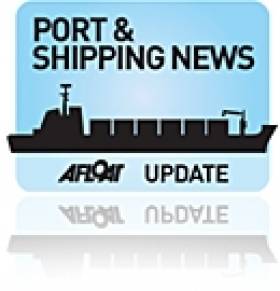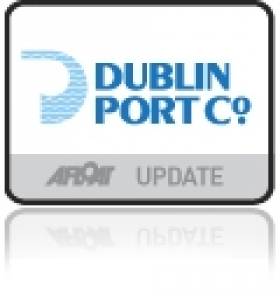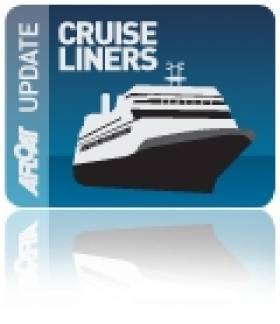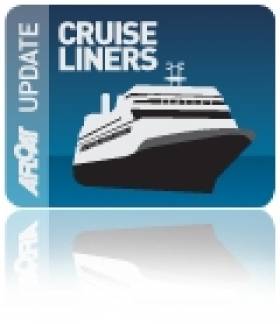Displaying items by tag: Dublin Port Company
#FORMER DUNDALK DREDGER – The former Dundalk Port Company owned dredger Hebble Sand (1963/757grt) departed the dry-dock in Dublin Port last week in readiness for her new owners Abco Marine Ltd, writes Jehan Ashmore.
Last October the vessel was sold by Dublin Port Company to Abco. The marine plant company based in Hillsborough Co. Down specialises in support services in the construction, engineering and dredging projects in Northern Ireland, Scotland and the Isle of Man.
The self-propelled grab-hopper dredger currently remains berthed at Alexandra Basin in Dublin Port, awaiting her delivery voyage. Despite nearing half a century, the veteran vessel remains in excellent condition considering the rough and tumble associated with dredging.
She last sailed into Dublin Port in July last year following the transfer of the Dundalk Port Company assets, liabilities and operations to Dublin Port Company by an order of statutory instruments.
Against this background, Dublin Port Company decided to divest in dredging business resulting in placing the Dundalk registered ship on the market for sale. The small ship at first glance resembles the last of the Guinness ships, The Lady Patricia and the world's first custom built liquid-bulk (pumped on board) stout tanker Miranda Guinness.
Unfortunately these vessels with such strong and unique histories were not saved from the breakers-torch whereas the humble Hebble Sand continues as a working ship. She is a testament to her builders Richard (Shipbuilders) of Lowestoft who built her for British Dredging and subsequent owners spanning a career at a shave off fifty years.
#DUBLIN PORT TUGS SOLD – Ben Eadar becomes the final member of an older generation of tugs to be sold having belonged to the Dublin Port & Docks Board (DP&DB) which was later to become the Dublin Port Company, writes Jehan Ashmore.
The 17-tonnes bollard pull (tbp) Ben Eadar (built 1973 / 198grt) was sold to ARPA & Co. of Setubal, Portugal, though ironically she may be towed to her new working grounds.
She was the oldest of the trio alongside her fleetmates Cluain Tarbh (1991/268grt) and Deilginis (1997/335grt).
They were eventually replaced when the first of a pair of newbuilds entered in 2009. The Deilginis therefore was the last tug commissioned by the DP&DB. In addition they were the last tugs named after Dublin Bay coastal suburbs spelt in Irish. Deilginis is a translation for Dalkey, Cluain Tarbh for Clontarf and Ben Eadar for Howth.
The 35tbp Cluain Tarbh was renamed Elliot in February after her transfer to new owners T.P. Towing in Gibraltar while the 37tbp Deilginis remains in Irish waters.
She made a delivery voyage several weeks ago to Killybegs to start a new career with Sinbad Marine Services. The newcomer replaces another Voith Schneider tug the Carron of 24tbp which was sold to the Forth Bridge Consortium.
With only 13,000 working hours clocked-up on Deilginis main Caterpillar engines, she is however to undergo an upgrade to install new piping and wheelhouse electronics amongst other alterations.
Currently the Deilginis is classified with Bureau Veritas and has a notation of coastal waters but Sinbad intend to upgrade this to Limited European Area (LEA) waters so to increase a greater operational role.
She joins the multi-purpose Sinbad fleet which provide coastal towage, berthing assistance, oil spill recovery, fire fighting and dredging assistance.
Shortsea 12, European Convention
#PORTS & SHIPPING - The Irish Maritime Development Office (IMDO) and Coastlink are to jointly host Shortsea 12, The European Shortsea Convention at the Mansion House, Dublin on 24th May 2012.
This year's event sponsored by the Dublin Port Company, will bring together Europe's senior executives, representing leading Shortsea operators (bulk and unitised) shippers & buyers of transport services, port and maritime terminal operators, logistics and supply chain companies.
The convention will provide a platform to network, discuss and debate current industry issues. In addition it will focus on the key Industry issues that are informed by the industry:
• State of the Shortsea Markets.
• Views of major European Exporters and Supply Chain managers.
• Analysis of current issues facing Shortsea Ports and Shipowners
A pre-conference high-level networking event will be hosted on the evening of the 23rd of May for delegates and industry executives.
For further information about Shortsea 12 click HERE
Cruise Passenger Rise in Dublin Port
#DUBLIN PORT-Cruise-passenger numbers in Dublin Port rose by 7.5% this year according to yesterdays' Irish Times.
During the 2011 cruise season, some 87 cruiseships brought over 135,000 passengers and crew to Dublin, delivering an estimated boost of between €35 and €55 million to the capital.
The port operator expects a similar number of cruise passengers next year. "Dublin Port's cruise season is becoming an increasingly important part of Dublin's tourism product," said chief executive Eamonn O'Reilly.
"Next year will see consolidation on our growth in recent years, while 2013 will see cruise line companies calling at Dublin for the first time and other operators bringing larger ships," he said.
Entry List Announced for Tall Ships Races 2012
#TALL SHIPS - Eighteen vessels are on the entry list for the 2012 Tall Ships Races which are set to conclude in Dublin Port next August.
The list is dominated by British entries, with all nine UK tall ships expected to sail the third and final leg from A Coruña in northern Spain to Dublin.
Tall ships from Russia, Poland, France, Ecuador, Bulgaria, Latvia, Estonia and Belgium will also be in the fray when Ireland's capital hosts the final port of call for the 2012 races, presented by Szczecin in Poland and organised by Sail Training International - a charity established to harness sail training to develop and educate young people regardless of nationality, culture, religion, gender or social background.
The first leg of the 2012 races kicks off in Saint-Malo, France on 7 July with ships racing to Lisbon in Portugal (till 21 July); Cádiz in southern Spain (21-28 July) and A Coruña (28 July-12 August) before the final leg.
Dublin will be hosting the Tall Ships Races for the first time since 1998. Earlier this year Eamonn O’Reilly, CEO of Dublin Port Company, said he was “delighted to welcome the Tall Ships Races to Dublin Port" in 2012.
Since the announcement the port has already played host to the British tall ship Tenacious and the Norwegian vessel S/S Statsraad Lehmkuhl.
From Thursday 23 to Sunday 26 August 2012 as many as 100 ships are expected to arrive in the port and Docklands area for an event that includes a four-day festival programme of music, food and fashion showcases, markets, street theatre, water sport and water-based activities.
The weekend will also feature activities unique to the races including a crew parade, prize-giving event and a parade of sail.
Are you looking to get involved in Dublin's hosting of the Tall Ships Races? Check out the following links:
Become a trainee www.dublintallships.ie/trainees/
Take part as a volunteer www.dublintallships.ie/volunteers/
For further information see www.dublintallships.ie or e-mail [email protected]
Entry List for the Tall Ships Races 2012:
Akela (Russia)
Black Diamond Of Durham (UK)
Dar Mlodziezy (Poland)
Etoile Polaire (France)
Guayas (Ecuador)
Johanna Lucretia (UK)
John Laing (UK)
Kaliakra (Bulgaria)
Lord Nelson (UK)
Maybe (UK)
Moosk (UK)
Pelican Of London (UK)
Pogoria (Poland)
Rona II (UK)
Spaniel (Latvia)
St Iv (Estonia)
Thermopylae Clipper (UK)
Tomidi (Belgium)
Former Dundalk Dredger Sold in Dublin Port
#DUBLIN PORT-The former Dundalk Port Company grab-hopper dredger Hebble Sand (1963/757grt), which has been laid-up in Dublin since last Summer, was sold to new owners a month ago, writes Jehan Ashmore.
She remains berthed at the Bulk Jetty, Alexandra Basin, where she arrived from the Co. Louth port on 14 July, two days after the assets, liabilities and operations of Dundalk Port Company were transferred to Dublin Port Company by an order of statutory instrument. Against this background, Dublin Port Company decided to divest in the business of dredging resulting in placing the veteran vessel for sale.
During her career in Drogheda, she was the only dredger to be operated and owned by a port company apart from the suction-trailer dredger Lough Foyle (1979/868grt) operated by Londonderry Port & Harbour Commissioners.
Hebble Sand, registered in Dundalk has retained her original name since her launch from Richard (Shipbuilders) of Lowestoft for British Dredging. She has been kept in good condition considering a career nearing five decades. To read some of her last contracts undetaken outside her homeport, click HERE.
From a distance some people have mistaken Hebble Sand (PHOTO) to the last of the 'Guinness ships, as she bores a resemblance to the final custom-built stout tanker Miranda Guinness ( PHOTO), taken on her farewell sailing. The vessels shared a similar red funnel and black funnel, a roomy sized superstructure painted in cream above and a dark blue hull. To read more about the last of the brewery tanker-fleet click HERE.
Dublin Port Outlines Plans for First Dedicated Cruise Terminal
In order to facilitate this growth, the draft proposes switching existing berths used by large cruiseships away from unattractive cargo-docks in Alexandra Basin's West and East and at Ocean Pier. Up to three alternative locations were examined and the port agreed that the option identified in the Dublin City Council's Area Plan of the North Quay Extension is the optimum location.
Before any such development, it would require relocating an existing roll-on roll-off terminal (No.3), which is currently in use by P&O Irish Sea for their Dublin-Liverpool service. The company operate three sailings daily on the central corridor route.
The new facility could accommodate two large cruise ships simultaneously and would be much larger than the 43,524grt The World, the luxury resort vessel operated by Residensea, which docked at the North Wall Extension in 2010 (for report click HERE).
The location is on the doorstep to the East-Link Bridge and the neighbouring O2 Arena and Point Village developed by Harry Crosbie, who called for the relocation of cruise callers to be sited upriver.
According to the draft, the closer proximity to the city-centre would provide a stronger presence and a more accessible link with the city. It would also avoid the unnecessary longer bus transfers between cruise berths and visitor attractions in the city-centre and locations in counties Wicklow and Meath.
Construction of facilities for a cruise terminal would expensive as it will involve new quay walls capable of accepting large cruise vessels but this could only be done after dredging the channel to a depth of 10.5m.
The facilities of the terminal are to incorporate a reception, tourist information and interpretive centre, a dedicated entrance for pedestrians, coaches, vehicles and traffic management measures would be implemented.
In addition the site would also require the expensive exercise in re-locating ESB underwater high-voltage cables. The initial costs suggest to develop new terminal facilities and associated works would be in the region of €30m.
Dublin Port Company, state that due to the relatively low revenues generated by cruise ships, such an investment alone could not be justified, however, they could part-fund the development but additional funding would be required from other sources.
- Dublin Port
- Dublin Port Company
- The World
- Cruise Liners
- Harry Crosbie
- Port of Dublin
- Ports and Shipping News
- Point Village
- P&O (Irish Sea)
- Cruise Liner news
- Ocean Pier Dublin Port
- O2 Arena
- EastLink bridge
- Dublin Port draft masterplan
- DPC
- North Wall Quay Extension
- Residensea
- Dublin Port Terminal 3
- Alexandra Basin Dublin
Dublin Port Turn-Around Offers Direct Cruises to the Sun
With a short-turn around in port, more cruise-goers will be boarding for a mid-afternoon departure, marking the start of a 13-night Canary Islands & Madeira cruise. When she heads out of the port, the first port of call is Falmouth then it's off to Leixoes (Portugal), Agadir (Morocco), Arrecife (Lanzarote), Las Palmas (Gran Canaria), Funchal (Madeira), Lisbon (Portugal) and Vigo (Spain) before returning to Dublin.
The vessels final end-of season cruise from Dublin is on 25 October, with a 10-night cruise to Nice (returning by air). The interim ports of call are to Falmouth, Leixoes, Lisbon, Cartagena (Spain) Palma and Mahon (Menorca). To read more about this cruise click HERE.
In addition to Dublin calls the former Cunard Countess, also called this season to Cork Harbour. It was during a call last month to Ringaskiddy that another 'Cunarder' the flagship, Queen Mary 2 was also in port on a call to Cobh. To read more of that visit click HERE.
Dublin Port: Display of East Wall Life & Docklands
A photographic display of 'Dublin Port and the East Wall' will be held in the Dublin Port Company Centre, Alexandra Road, on Saturday 15th October.
The archives from the ports extensive collection depict how life was for generations who worked in the docklands over the years and the close historical links of the community.
The display forms part of the 'East Wall for All' History Week which runs until 24th October. The programme for events are listed below.
"East Wall - a journey through time" Sean O'Casey Community Centre, Friday 14th October
Dublin Port - a shared history", Port Centre, Alex Rd - Saturday 15th October
Collen - "Two centuries of building", Three Gateway, East Wall Rd. - Wednesday 19th October
"The Shadow of O'Casey", Sean O'Casey Community Centre - Saturday 22nd October
"Shadow of a Gunman" - 18th - 22nd October, Sean O'Casey Community Centre
The 162 gross tonnes tug had served a career of nearly three decades in Dublin Port, after entering service in 1972. Prior to working in Irish waters the 100ft tug spent the previous decade operating in the UK as Appelsider for Lawson-Batey Tugs Ltd who chartered her to Tyne Tugs Ltd. For historical record and photos click HERE.
In 1998 the Dublin Port Company disposed of the Coliemore alongside her running mate Clontarf (1963/178grt) the former Cluain Tarbh, also built from the same Yorkshire shipyard on the banks of the River Humber.
Initially they were towed to Liverpool but they later appeared at Cork Dockyard in 1999. The Clontarf remained there for a year until she was sold to Barcazas Dominicia SA, Santo Domingo in the Dominican Republic. For photo of the tug in far distant waters click HERE. It was intended Coliemore would follow her Caribbean counterpart but her sale fell-through.
The vessel's ownership eventually transferred to Cork Dockyard where her scrap value will pay for her long-term berthing fees. The tug recently made her final short journey under tow from her berth at the former Verolme Cork Dockyard (VCD) to the facilities slipway where work to break-up the vessel began.
Coliemore and her fleet-mates were given the traditional naming theme of Dublin Bay coastal suburbs spelt in Irish. The naming policy was used by the Dublin Ports & Docks Board (DP&DB) which operated the fleet remained until transferred to the Dublin Port Company established in 1997.
The last tugs to carry the traditional names, Ben Eadar (Howth), Cluain Tarbh (Clontarf) and Deilginis (Dalkey) are now up laid-up awaiting to be sold, to read more click HERE.
Between the 14-16th centuries Dalkey Sound became increasingly important as larger vessels with deeper drafts could no longer enter the port in Dublin due to the dangers of constantly shifting sandbanks and swallow channels in Dublin Bay.
The nearest alternative was for vessels to anchor off Dalkey Island and in the relative shelter of Dalkey Sound where cargoes for the capital where transferred to and fro by lighters to the coastline along Dalkey at Coliemore, which became the principle port for Dublin. Some of the cargo was stored temporally in the medieval castles in Dalkey, otherwise it was directly transported by horse and cart across the plateau to the city.
It was not until the 17th century that the issue of accessing the port of Dublin was resolved, with the completion of the harbour walls that enabled shipping to return on a frequent basis. Captain Bligh of the 'Mutiny on the Bounty' completed mapping Dublin Bay in 1803 which became the most accurate chart at the time and this aided to the safety of mariners.
The fortunes of Dublin's shipping trade increased due to the combination of an easier and safer navigational channel and deeper depths along the quaysides. This led to the eventual demise of shipping using Dalkey. The present-day harbour structure at Coliemore Harbour was constructed in 1868 and is home to a humble fleet of recreational boats and a passenger-ferry service to the island.
- Howth
- Dublin Bay
- Dublin Port
- Clontarf
- Dublin Port Company
- dalkey
- coliemore harbour
- Dalkey Island
- Port of Dublin
- Ports and Shipping News
- Cork Harbour News
- Verolme Cork Dockyard
- VCD
- Dalkey Sound
- Mutiny on the Bounty
- Dublin Port Tugs
- Deilginis
- Captain Bligh
- Dublin port tugs for sale
- Coliemore
- Coliemore tug
- Cork Dockyard
- Cork Dockyard Rushbrooke
- Cluain Tarbh tug
- Ben Eadar tug
- Deilginis tug
- Richard Dunston (Hessle) Yorkshire
- River Humber
- Dublin Ports & Docks Board
- DP & DB
- Cork Dockyard shiprepairers
- Irish shipbuilding






































































